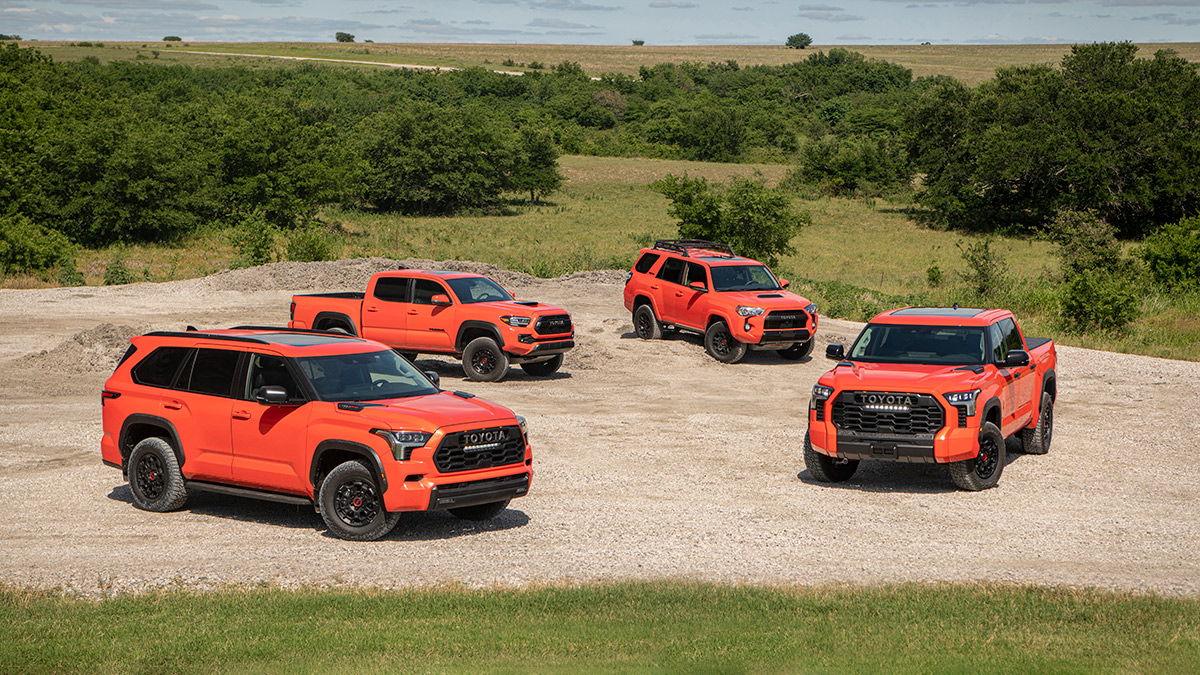Quick Facts About Trucks vs. SUVs
- Trucks and SUVs probably have much more in common than you realize.
- SUVs provide more seating options, family friendliness, and cargo security than trucks.
- Trucks have the advantage over SUVs in towing capacity, hauling capability, and fuel economy.
If your vehicle must perform multiple functions, such as hauling people, cargo, or towing, you may be considering SUVs and trucks. Although SUVs provide an edge in hauling people, trucks would seem to do better at carting cargo and towing. However, depending on the number of people, the size and shape of the cargo, and the weight of the tow load, there is an area of overlap where either an SUV or a truck makes perfect sense. In other words, unless your needs are extreme in one area or another, don’t dismiss trucks or SUVs out of hand. Odds are, either the right truck or the right SUV can fulfill your requirements.
Also, let’s consider whether a truck or an SUV is the better vehicle for transporting the family and camping. Within this scenario, we can cover a wide range of vehicle functions like passenger space, technology, towing, fuel economy, and other variables. We’ll drill down into trucks and SUVs to determine what each vehicle class brings to the table. The goal, of course, is to help resolve the dilemma of which vehicle works best for you. We provide the jump links below to help you skip ahead if needed.
- Comparing a Truck With an SUV: What You Need to Know
- What Trucks and SUVs Have in Common
- How Are Trucks and SUVs Different?
- Truck vs. SUV: The Results
- Things to Consider When Picking Between a Truck and an SUV
- Our Take
Comparing a Truck With an SUV: What You Need to Know
Trucks and SUVs probably have much more in common than you realize; however, the differences increase or decrease based on the comparisons you make. Comparing the Ram 1500 truck with the GMC Yukon SUV or the Ford Maverick pickup with the Hyundai Santa Fe SUV will produce fewer differences than comparing the Ram 1500 with the Maverick or the Yukon with the Santa Fe. Wait. What?
That’s right. While our debate does concern size (full-size, midsize, or compact) and body type (truck or SUV), it’s more about a vehicle’s innate ability to fulfill your needs. All things being equal, a larger vehicle can carry more people and cargo than a smaller one. However, manufacturers produce both large trucks and SUVs, as well as smaller trucks and SUVs. There is more to a vehicle’s capabilities than its size or body type. Only after you determine precisely what you require of your truck or SUV can you zero in on size and body type. For this reason, we’ll stick to trucks and truck-based SUVs. Read on to find out why.
Body-on-Frame vs. Unibody Construction
We need to veer into the weeds a bit here to discuss why some trucks and SUVs are more capable hauling, towing, and off-roading than others.
What Is Body-on-Frame Construction?
At the dawn of the automobile era, body-on-frame construction was the norm. That is, the car’s body and frame were two distinct components bolted or welded together. In fact, for the initial decades of car making, it was common for the body and frame of a car to come from two totally different builders. For instance, it wasn’t until the mid-1980s that “Body by Fisher” labels disappeared from General Motors products. By that time, Fisher was a subsidiary of GM, but it had not begun as such. The body-on-frame method used the same frame for a wide assortment of models. Because the body can be separated from the frame, crash repair costs are often lower, too. Despite these features, as technology progressed, a lighter and more cost-effective unibody alternative surfaced. Car manufacturers liked lighter and cheaper; consequently, body-on-frame architecture fell out of favor. Today, only a handful of trucks and SUVs remain body-on-frame.
Among the advantages of body-on-frame construction:
- Higher towing capacity
- Greater hauling capability
- More off-road competence
- Lower collision repair costs
What Is Unibody Construction?
Nearly all vehicles today use unibody construction. With this method, the vehicle’s frame serves as the entire skeleton, to which body panels and other components are attached. Designing and building a unibody vehicle is somewhat more complex than one using body-on-frame technology. However, the lighter weight of a unibody vehicle improves fuel economy, enhances its crash-management properties, and lowers its center of gravity, thereby improving driving dynamics.
Among the advantages of unibody construction:
- More affordable to assemble
- Enhanced crash management
- Better fuel economy
- Improved driving dynamics
MORE: Best SUVs for Towing in 2025: Everything You Need to Know
SUV vs. Crossover
So what makes an SUV an SUV, and what makes a crossover a crossover? Some carmakers have muddied the waters, identifying certain crossovers as SUVs, to make them seem more capable. We, the automotive press, have also participated in using SUV broadly to include crossovers. However, there is a defining distinction between SUVs and crossovers, which must be understood when deciding between a truck and an SUV. That distinction: Like trucks, many SUVs are products of body-on-frame construction. A crossover has unibody construction. For its first four generations, the Ford Explorer was a body-on-frame SUV. With its fifth generation, launched in 2011, it became a unibody crossover. For our purposes here, any reference to SUV means a vehicle with body-on-frame construction.
Examples of Body-On-Frame SUVs
- Cadillac Escalade and Escalade ESV
- Chevrolet Tahoe
- Chevrolet Suburban
- GMC Yukon and Yukon XL
- Ford Bronco
- Ford Expedition and Expedition Max
- Infiniti QX80
- Jeep Wagoneer and Wagoneer L
- Jeep Wrangler
- Lexus GX
- Lexus LX
- Lincoln Navigator and Navigator L
- Mercedes-Benz G-Class
- Nissan Armada
- Toyota 4Runner
- Toyota Land Cruiser
- Toyota Sequoia
What Is a Truck?
Every midsize and full-size pickup truck is a body-on-frame vehicle. However, manufacturers also make three smaller pickups (the Ford Maverick, Honda Ridgeline, and Hyundai Santa Cruz) with unibody construction.
What Trucks and SUVs Have in Common
For the most part, just about any technology, convenience, or luxury feature you can find in an SUV, you can find in a truck, and vice versa. We’ll stick our neck out and claim that, in general, SUVs are probably more family-friendly than even full-size pickup trucks. For example, many SUVs offer available rear-seat entertainment systems (unavailable for trucks), along with more cupholders and USB ports than the average pickup truck. Furthermore, you can also get some SUVs with three rows of seats, which isn’t an option in a truck. Otherwise, in terms of comfort, quiet, and popular features, there’s not a lot of notable difference within the passenger area between a truck and an SUV. Granted, truck buyers may need to dip into the options to add some advanced safety tech typically found on SUVs as standard; however, most safety features are available.
Ultimate Overlanding Vehicles
If you are caught up in the current overlanding craze, you may be on the hunt for the ultimate adventure vehicle. Well, you’re in luck because the trucks and SUVs we are featuring in this article are among the ultimate overlanding vehicles. Overlanding is a form of extreme, off-the-grid camping that incorporates off-roading elements. If you end up at a location with campsites, RV hookups, or latrines, you’re not overlanding. Trucks and body-on-frame SUVs are ideal overlanding trekkers capable of customizing with aftermarket tents and other add-ons to make just about any outdoor adventure possible. Their rugged construction, better-than-average ground clearance, and competent 4-wheel-drive systems can get you to those prized, less-visited areas.
MORE: What Is Payload: A Complete Guide
How Are Trucks and SUVs Different?
When comparing trucks and SUVs, both have their positive and negative aspects. So, for our truck-vs.-SUV family hauler/camping comparison, let’s consider the pros and cons of each. Any pricing we use is based on the latest manufacturer’s suggested retail price (MSRP), including the mandatory factory-to-dealer delivery fee (destination charge).
Full-Size Truck Pros
- Cost Less: At the end of the day, the cost of any vehicle we buy is a product of the choices we make. Trim levels, options, and our negotiating skills determine the final cost. However, when comparing the entry-level base price of full-size trucks and SUVs, trucks cost less. For example, the 2025 Ford F-150 SuperCrew Cab starts at $46,290. Compare that to the Ford Expedition’s starting price of $64,515, and that’s for the regular-length version. The Expedition Max goes for $67,515.
- Better fuel economy: Whether comparing full-size or midsize trucks with like classifications of non-hybrid SUVs, trucks tend to get better fuel economy than their truck-based SUV counterparts. With their base engines and rear-wheel drive, most full-size trucks get between 20 and 22 mpg in mixed city-and-highway driving. For example, the Ford F-150 SuperCrew and Ram 1500 Crew Cab get 21 mpg. With the exception of the Toyota Sequoia (22 mpg) with its hybrid powertrain and the Jeep Wagoneer (20 mpg), full-size SUVs post EPA estimates in the high teens. One contributing factor is that full-size trucks tend to weigh less than their body-on-frame SUV counterparts. For context, our Ford F-150 SuperCrew tips the scales at about 4,705 pounds, while the Ford Expedition weighs in at just over 5,404 pounds. You can find out more about truck and SUV mileage on the EPA website.
- Maximum towing capacity: Big pickups’ ability to out-tow big SUVs is important for families tugging a trailer on their wilderness adventures. Be it a boat, RV trailer, or other heavy load, towing is a key reason many owners have a truck. Maximum towing specifications are tough to pin down or compare because the carmakers tend to play with the numbers, which are also affected by cab configuration and engine size. However, within the Chevy brand, the Suburban can pull up to 8,200 pounds, while the Silverado 1500 Crew Cab armed with a V8 engine can tow up to 13,300 pounds. If we toss heavy-duty pickups into the mix, the Silverado 3500 HD Crew Cab can tug up to nearly 22,000 pounds. Furthermore, a pickup truck also provides the option for fifth-wheel towing, in which the hitch is inside the bed of the truck. You can learn more about towing and hauling capacity by checking out our Towing Capacity Guide: Everything You Need To Know.
- Greater payload capacity: Payload is the total amount of weight a vehicle can haul. It includes the driver, passengers, luggage, and any other cargo. Plus, if towing a trailer, it includes the trailer tongue weight. Here again, full-size trucks can carry more payload than full-size, body-on-frame SUVs. The Chevy Silverado 1500 Crew Cab has a maximum payload rating of 2,530 pounds with a V8 engine, while the Suburban’s maximum rating is 1,759 pounds. Those 771 pounds can make the difference between inviting Uncle Augie and Aunt Wenona along or leaving them at home.
- More cargo options: No matter if the cargo meets an SUV’s weight restrictions, the shape of the cargo must fit through the rear liftgate opening and then fit inside the SUV’s cargo area. Pickup trucks allow for varying cargo shapes and sizes. Moreover, any dirt, mud, or other debris left behind in the cargo hold can be simply hosed out of a truck bed.
MORE: Towing Capacity Guide: Everything You Need to Know
Full-Size Truck Cons
- Seating capacity: If you need to take more than five people (or possibly six, if the truck has a front bench seat) on your camping adventure, or anywhere else, for that matter, you’ll need at least another row of seats. In other words, trucks max out at two rows.
- Cargo security: Let’s face it, anyone serious about making your stuff theirs will find a way to get it. However, the first rule of security is to make it tougher to grab your stuff than someone else’s. In this sense, cargo in the bed of your truck is easy pickings. Sure, there are locking tonneau covers; however, those defeat the cargo shape advantage we discussed in the “pros” section, likewise with cargo-box toppers.
- Parking issues: Although a full-size SUV has its own parking disadvantages, full-size trucks can be 10 inches or more longer than the biggest full-size SUVs. Maybe another foot or so in length doesn’t mean much when you are already trying to park a 17- to 18-foot SUV, but another foot is another foot.
Full-Size SUV Pros
- More seating: A full-size 3-row SUV can have seating for up to eight people if fitted with a second-row bench seat — or up to nine in the case of Chevy and GMC models with a front bench seat. For larger parties booked on a trip, more seating is essential.
- More family-friendly: We admit, you can find trucks that are every bit as luxurious and comfy as a high-end sedan. However, where trucks are ultimately engineered for work, SUVs, even body-on-frame SUVs, tend to be more sensitive to the requirements of families. This includes more conveniently located cupholders, USB data/charging ports, and child-seat LATCH systems. Another feature available on many SUVs is a rear-seat entertainment system. Not one pickup truck offers this option to help keep the kiddies entertained.
- Better security: Sure, all it takes is a tire iron, a hammer, or a big rock to access the cargo area of an SUV, but breaking into an SUV is more involved and attention-grabbing than reaching over a truck’s cargo bed rail and snatching something. Moreover, an SUV with darkened rear windows or a cargo cover can mask the cargo.
- Second-row captain’s chairs: Most 3-row SUVs at least offer the option of captain’s seats in the second row. More comfortable than a bench seat, captain’s seats are a better place to spend a few hours, particularly if you are bouncing around off-road. No pickup truck offers second-row captain’s seats.
Full-Size SUV Cons
- Less fuel efficient: Already discussed in the truck pros section, full-size, non-hybrid, body-on-frame SUVs generally deliver fewer mpg than full-size trucks.
- More expensive: The average full-size SUV has a higher base price than the average full-size truck.
- Cargo restrictions: Only cargo of limited shapes and sizes can be loaded into or fit inside the cargo area of an SUV.
- Difficult to park: Although not as tricky to park as a full-size truck, a full-size SUV is still a bear to maneuver in tight quarters.
MORE: Maximum Towing Capacity For Every Truck
Full-size Truck vs. Full-size SUV: Which Is Safer?
We try to avoid saying, “it’s science.” However, in the case of full-size trucks and SUVs, bigger and heavier always seem to come out ahead in a frontal crash. Structurally, mass wins out, at least for the driver. A smaller crossover or sedan is simply no match for a full-size SUV or truck in the most common fatal accident, a frontal collision. Applying that bit of physics to a comparison of full-size trucks to full-size SUVs in a crash, SUVs typically outperform trucks in protecting their occupants. Some of this is due to an SUV’s additional mass; however, more is likely related to the fact that SUVs often have more advanced safety features and cabin integrity than trucks. In light of this — and as a broad generalization — we’d give our nod to the SUV as the safer of the two.
However, the difference between modern full-size SUVs and pickups is not categorical. The IIHS finds both have improved compatibility with other vehicles. Driver-death-rate data varies by model and weight, and very heavy pickups can pose a higher risk to other drivers.
Truck vs. SUV: The Results
The “which is better” question is really a subjective one. A full-size truck will cost less to buy and fuel, it has more flexible cargo solutions, can tow more, and haul more. A full-size 3-row SUV can accommodate more people, better secure belongings, offer more child-seat positions, and better serve the requirements of today’s high-tech families.
In other words, it all boils down to your specific wants and needs.
Truck vs. SUV Scorecard
| Full-Size Truck | SUV | |
| Price | X | |
| Towing | X | |
| Payload | X | |
| Passenger Count | X | |
| Fuel Efficiency | X | |
| Cargo Security | X | |
| Family-Friendly | X | |
| Safety | X |
Things to Consider When Picking Between a Truck and an SUV
- Price
- Passenger count
- Fuel economy
- Cargo requirements
- Towing requirements
- Payload capacity
- Safety/Advanced safety tech
Our Take
Our proposition is that when considering a full-size SUV or a full-size truck, there exist many needs that they are both well-suited to fulfill. Sure, each has its strengths, but there is plenty of middle ground, too. It’s in that middle where the real decision between SUV and truck lies. There, the choice distills down to budget, accommodations, amenities, and image.
Editor’s Note: This article has been updated since its initial publication.








